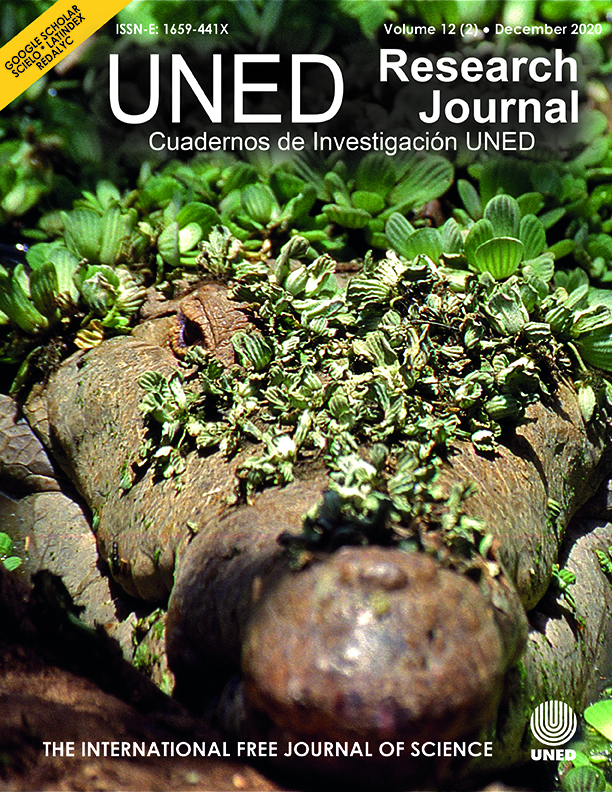Feeding interactions between the deer, Odocoileus virginianus (Mammalia: Cervidae) and four species of birds in Costa Rica
DOI:
https://doi.org/10.22458/urj.v12i2.3119Keywords:
Comensalism, Protocooperation, White-tailed deer, BirdsAbstract
Introduction: Mammalian-bird interactions are poorly known in the tropics. Methods: To analyze the inteactions between White-tailed Deer and birds I noted and photographed interactions in the tropical humid forest of Curú, Costa Rica, between July 2005 and October 2019. Results: The most common interaction was with the Groove-billed Ani (82 % of all observations), followed by the White-throated Magpie-Jay (10%), Crested Caracara (5%) and Yellow-headed Caracara (3%). Conclusion: Although some of these interrelationships had already been reported in other locations, these results are new for Costa Rica.
References
Begon, M., Townsend, C. R, & Harper, J. L. (2006). Ecology: From Individuals to Ecosystems. Malden, MA, USA: Blackwell Publishing.
Bolaños, R. A., & Watson, V. (1993). Mapa Ecológico de Costa Rica [Mapa]. San José, Costa Rica: Centro Científico Tropical.
Brokx, P. A. (1984). South America. En L. K. Halls (Ed.). White-tailed Deer, Ecology and Management (pp. 525546). Harrisburg, PA, USA: Stackpole Books.
Carreno, R. A., Durden, L. A., Brooks, D. R., Abrams, A., & Hoberg, E. P. (2001). Parelaphostrongylus tennis (Nematoda: Protostrongylidae) and Other Parasites of White-Tailed Deer (Odocoileus virginianus) in Costa Rica. Comparative Parasitology, 68(2), 177-184.
Dean, W. R. J., & MacDonald, I. A. W. (1981). A review of African Birds Feeding in Association with Mammals. Ostrich: Journal of African Ornithology, 52(3), 135-155. DOI: 10.1080/00306525.1981.9633599
Durán, F. (2003). Forrajeo de urraca copetona Calocitta formosa (Aves: Corvidae), sobre venado cola blanca Odocoileus virginianus (Mammalia: Cervidae). Brenesia, (5960), 89-90.
Michael, E. D. (1967). Behavioral interactions of Birds and White-tailed Deer. The Condor, 69(4), 431-432.
Pietz, P. J., & Granfors, D. (2000). White-tailed Deer (Odocoileus virginianus) Predation on Grassland Songbird Nestlings. The American Midland Naturalist, 144(2), 419-422.
Riney, T. (1951). Relationship between Birds and Deer. The Condor, 53(4), 178-185. DOI: 10.2307/1364874
Schutt, A., & Vaughan-Dickhaut, C. (1995). Incorporating wildlife into development: the case of the Curú Wildlife Refuge and Farm, Costa Rica. En J. A. Bissonette y P. R. Krausman (Eds.). Integrating people and wildlife for a sustainable future (pp. 250-254). Bethesda, MD, USA: Wildlife Society.
Smith, T. M., & Smith, R. L. (2007). Ecología (trad. E. San José Román). Madrid, España: Pearson Educación.
Tymkiw, E. L., Bowman, J. L., & Shriver, W. G. (2013). The effect of white‐tailed deer density on breeding songbirds in Delaware. Wildlife Society Bulletin, 37(4), 714-724.
Published
How to Cite
Issue
Section
License
Note: This abstract contains an incorrect copyright due to technical issues. Authors who publish with this journal agree to the following terms: Authors retain copyright and grant the journal right of first publication with the work simultaneously licensed under a Creative Commons Attribution License that allows others to share the work with an acknowledgement of the work's authorship and initial publication in this journal
All journal contents are freely available through a CC BY 4.0 license.
CC BY 4.0 is a Creative Commons: you can copy, modify, distribute, and perform, even for commercial reasons, without asking permission, if you give appropriate credit.
Contents can be reproduced if the source and copyright are acknowledged according to the Open Access license CC BY 4.0. Self-storage in preprint servers and repositories is allowed for all versions. We encourage authors to publish raw data and data logs in public repositories and to include the links with all drafts so that reviewers and readers can consult them at any time.
The journal is financed by public funds via Universidad Estatal a Distancia and editorial independence and ethical compliance are guaranteed by the Board of Editors, UNED. We do not publish paid ads or receive funds from companies.
